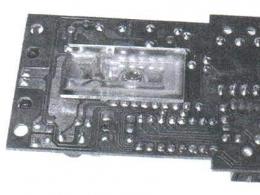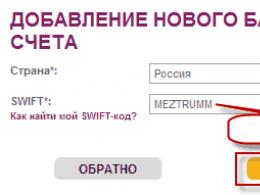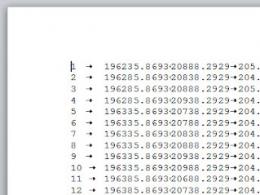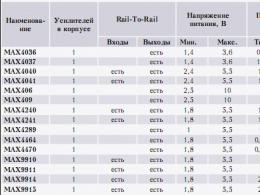Why do artifacts appear on the screen? Video card artifacts: what to do, how to fix them? Causes and solutions
Hello.
While many errors and problems on the computer can be tolerated, defects on the screen (the same stripes as in the picture on the left) cannot be tolerated! Not only do they interfere with your view, but they can also damage your eyesight if you work on such an image on the screen for a long time.
Stripes on the screen can appear for various reasons, but most often they are associated with problems with the video card (many people say that artifacts have appeared on the video card...).
Artifacts mean any distortion of the image on a PC monitor. Most often, they appear as ripples, color distortion, stripes with squares across the entire area of the monitor. So what to do with them?
Right away I want to make a small disclaimer. Many people confuse artifacts on the video card with dead pixels on the monitor (a clear difference is demonstrated in Fig. 1).
A dead pixel is a white dot on the screen that does not change color when the picture on the screen changes. Therefore, it is quite easy to detect by filling the screen with different colors one by one.
Artifacts are distortions on the monitor screen that are not related to problems with the monitor itself. It’s just that the video card sends such a distorted signal to it (this happens for many reasons).
There are software artifacts (related to drivers, for example) and hardware artifacts (related to the hardware itself).
Software artifacts
As a rule, they appear when launching some 3D games or applications. If you experience artifacts when loading Windows (also in), most likely you are dealing with hardware artifacts (about them below in the article).
There are a lot of reasons for the appearance of artifacts in the game, but I will analyze the most popular ones.
1) Firstly, I recommend checking video card temperature at work. The thing is that if the temperature has reached critical values, then everything is possible, from distortion of the picture on the screen to failure of the device.

You can read about how to find out the temperature of a video card in my previous article:
If the temperature of the video card exceeds the norm, I recommend cleaning the computer from dust (and paying special attention to the video card when cleaning). Also pay attention to the operation of the coolers; perhaps one of them is not working (or is clogged with dust and does not spin).
Overheating most often occurs in hot summer months. To reduce the temperature of the system unit components, it is even recommended to open the unit cover and place a regular fan opposite it. This primitive method will help to significantly reduce the temperature inside the system unit.

How to clean your computer from dust:
2) The second reason (and quite common) is drivers for video card. I would like to note that neither new nor old drivers provide a guarantee of good performance. Therefore, I recommend updating the driver first, and then (if the picture is just as bad) rolling back the driver or installing an even older one.
Sometimes using “old” drivers is more justified, and for example, they more than once helped me enjoy a game that refused to work normally with new versions of drivers.

How to update drivers with just 1 click:
3) Update DirectX and .NetFrameWork. There is nothing special to comment here, I will give a couple of links to my previous articles:
4) Lack of shader support will almost certainly result in artifacts on the screen ( shaders- these are a kind of scripts for a video card that allow you to implement various special functions. effects in games: dust, ripples on the water, particles of dirt, etc., everything that makes the game so realistic).
Usually, if you try to run a new game on an old video card, you get an error saying that it is not supported. But sometimes this does not happen, and the game runs on a video card that does not support the required shaders (there are also special shader emulators that help run new games on old PCs).
In this case, you just need to carefully study the system requirements of the game, and if your video card is too old (and weak), then, as a rule, you won’t be able to do anything (except overclocking...).
5) At overclocking a video card Artifacts may appear. In this case, reset the frequencies and return everything to its original state. In general, overclocking is a rather complicated topic and if not handled correctly, you can easily damage the device.
6) A glitchy game can also cause image distortion on the screen. You can usually find out about this by looking at various player communities (forums, blogs, etc.). If there is such a problem, then you are not the only one who will encounter it. Surely, they will also suggest a solution to this problem (if there is one...).
And hardware artifacts
In addition to software artifacts, there may also be hardware artifacts, the cause of which is poorly functioning hardware. As a rule, you will have to observe them absolutely everywhere you are: in the BIOS, on the desktop, when loading Windows, in games, any 2D and 3D applications, etc. The reason for this, most often, is the detachment of the graphics chip; less often, there are problems with overheating of the memory chips.
For hardware artifacts, you can do the following:
1) Replace chip on video card. Expensive (relative to the cost of the video card), it’s tedious to look for an office that will carry out repairs, it takes a long time to search for the right chip, and other problems. It is still unknown how this repair will be carried out for you...
2) Trying on your own warm up the video card. This topic is quite extensive. But I will say right away that such a repair, even if it helps, will not help for long: the video card will work from a week to six months (sometimes up to a year). You can read about warming up the video card from this author: http://my-mods.net/archives/1387
3) Replacing the video card with a new one. The fastest and simplest option, which sooner or later everyone comes to when artifacts appear...
That's all for me. Good PC work to everyone and fewer errors :)
Artifacts when loading Windows and BIOS appear when the video card is faulty or overheated.
What are artifacts?
Artifacts- these are stripes, dots, and other picture defects that may appear on the computer screen while the device is operating or turned on. In rare cases, this problem is associated with a monitor failure, but most often the video card is to blame.
Important! Some users confuse dead pixels with artifacts. Below, the first picture shows a dead pixel, and the second shows artifacts:

As you can see, the difference between dead pixels and artifacts is significant. Dead pixels are dots on the monitor caused by defects in the monitor matrix. Artifacts appear due to a faulty video card.
How to remove artifacts when loading Windows?
The reasons for the appearance of artifacts can be software or hardware.
Software artifacts
Update DirectX, its latest version can be downloaded from this link.
Update your video card drivers.
If artifacts occur only when working with a specific program or game, then try updating it to the latest version.
If you overclocked your video card, reset the settings to factory settings.
Hardware problems
- Check if your video card is overheating (). During normal work on a computer, the temperature of the video card should not exceed 50-60 degrees. When you turn on computer games, the load on the video card increases greatly and the normal temperature of the video card can be considered 85-90 degrees. If the temperature is higher, it can cause artifacts and can lead to complete failure of the equipment.
- The video card could have failed, in which case nothing can be done and it must be replaced. Video cards cannot be repaired.
Artifacts when loading BIOS
If artifacts appear immediately when the computer starts, while the BIOS data is displayed on the screen, and the computer was turned off for a long time before, in 90% of cases the video card is damaged and nothing can be done.
If you have any questions, please write them in the comments.
In computer terminology, artifacts usually refer to various distortions that can appear on the screen. In this article, we will look at the most common reasons that can lead to the appearance of artifacts on a monitor screen or laptop display, and also give some recommendations for eliminating them.
Reason #1: Cable problems.
The most common reason for artifacts appearing on a monitor screen is problems with the cable. Therefore, if such problems occur, first of all, check how the cable is connected to the video output of your computer and the video input of the monitor. Try disconnecting the cable and connecting again. Pay special attention to the fixing screws that are located on the sides of the connectors and VGA. Try to tighten these screws as tightly as possible, this will secure the cable in the correct position.
If reconnecting does not help remove artifacts from the screen, then try replacing the cable. If you don't have the exact same cable at hand, you can try connecting the monitor using a different type of cable. Monitors usually have at least two video inputs of different types.
If you have a laptop, then artifacts can also be caused by problems with the display connection. In this case, the laptop will have to be taken to a service center.
Reason No. 2. Overheating of the video card.
The next thing you need to check if artifacts occur is the temperature of the video card. Different video cards have different values. But, if we give typical values, then the maximum temperature of the video card is usually considered 80 degrees Celsius. If the temperature of your video card significantly exceeds this value, this may lead to artifacts.
The correct display of information on the monitor screen depends on the stability of the video card. This is true for both desktop computers and laptops. If a separate video card is not installed in the computer, the graphics core of the processor is responsible for displaying information on the screen.
Experienced computer users know the concept of video card artifacts. It refers to distortion of the image on the monitor screen caused by improper operation of the graphics component of the system. Due to video card artifacts, “phantom” elements appear on the screen, some displayed images are doubled, tripled, and distorted in various ways, making it difficult or impossible to receive information from the computer screen.
Video card artifacts can occur due to software or hardware problems, and below we will look at the reasons that most often lead to them.
Software reasons for video card artifacts

Artifacts often appear on the screen when running a resource-intensive application. For example, such an application could be a modern game that requires a large load on the video card. To fix artifacts caused by software, it is recommended to do the following:

If none of the above tips helped fix the situation and artifacts continue to appear on the screen when launching productive applications, it is recommended to check whether the situation is related to a problem in the performance of a specific game. Due to poor optimization on the part of the developers, artifacts may be observed on the screens of players with some video card models. Most often, developers correct these errors with the first patches.
Note: If the minimum system requirements of a game indicate the amount of memory required for correct operation at a level higher than that of the installed video card, this can often cause artifacts to occur.
Hardware causes of video card artifacts
If during software problems artifacts appear only in certain applications, then if the hardware failure of the video card, image distortion will be widespread. That is, artifacts will begin to appear immediately after loading the operating system, and then they will be ubiquitous in the interface and various applications. There are two main hardware reasons for the occurrence of artifacts on the screen:

It is worth noting that various services undertake to “treat” the detachment of the graphics chip. However, if this problem occurs, you need to think about buying a new video card, since the refurbished version usually works for no more than six months, after which the chip finally fails.
If you are tired of all kinds of distortions on the monitor, flickering, ripples and any artifacts in general, then in this article you can find a solution to this problem, and perhaps fix everything yourself.
Artifacts on the monitor screen - as I already said, these are all sorts of image distortions, ripples and flickering on the monitor screen. There are many reasons for this problem. Starting from outdated video card drivers to component breakdowns.
Artifacts can be like this:

Or they could be:

And in general, there can be all sorts of artifacts, the main thing is that the principle is the same. By the way, if this article does not help you solve the problem, there are other tips that I advise you to read.
Reasons for artifacts appearing on the screen
Video card malfunction
The first thing that comes to mind in such a situation is the breakdown of the video card itself. Perhaps the video card has failed due to severe overheating, here you need to remember whether it was carried out, if this was the case, then you need to take measures to reset the overclocking settings (everything is described in the article at the link above). And if it’s not too late, then the video card will work as it should; if overclocking was not carried out, then perhaps the video card has failed, because the time has come.
Video card drivers
There is a situation when artifacts appear, for example, in some specific programs or games. In this case, the problem may be with the video card drivers. The article describes in detail the process of updating drivers for Nvidia, AMD, Intel video cards. If it turns out that the reason for the appearance of artifacts on the screen is not due to outdated and crooked drivers, then proceed to the next step.
Overheat
Overheating of individual computer components can easily cause distortions, ripples, multi-colored stripes and squares on the screen. What exactly is called artifacts. And so, straight to the point.
- The first thing you need to do is find out which one exists (processor, video card, chipset), and also take temperature readings from the computer or laptop monitor that has suffered from artifacts. Fortunately, in that article (link above) I tried to present everything in a language that everyone could understand. If it turns out that everything is in order with the temperature of your computer components, then the reason is not overheating, then skip the “Overheating” section and move on to the next point. If, after checking the temperature, it turns out that some component is overheating, then let's look into it further.
- If the problem is with the processor, then the thermal interface may have dried out; here you need to read the article, which describes in detail the process of changing the thermal paste of the processor and video card. There may be another reason, for example, the video card was overclocked.
- Perhaps the cause of overheating was dust, read the article. If the radiator mesh and fan are clogged, then there is simply not enough air to completely cool the components.

In fact, finding out the reason is very simple, just open the lid of the system unit or laptop and visually assess the condition; if there is a lot of dust on the fan or radiator grid, then 99% of the reason is this dust, it needs to be cleaned urgently.
power unit
The reason for the appearance of artifacts on the screen may also be a weak power supply. Here you need to try to connect a more powerful power supply and if the problems are resolved, then this is the reason, there is only one way out - to purchase a new one.
Motherboard
If, after visually inspecting the motherboard, you find blown capacitors, cracks and any other physical damage on it, then it may well be that artifacts appear for this reason. And if the reason for the appearance of your artifacts is precisely the failure of the motherboard, then I must disappoint you that repairing it on your own is practically impossible, and repairing a motherboard from specialists can cost almost the same as the cost of a new one.
Artifacts on the screen can also appear for other reasons; this article lists only the main, most common ones. If the article did not help you, then you can contact me by writing in the comments, and we will solve your problem together.
(1
ratings, average: 5,00
out of 5)
: 10 comments
- Alexander
Hello, artifacts appeared on my monitor in the form of small horizontal stripes scattered across the entire screen. The problem is definitely systemic, but what exactly? There is no external damage, but when you lift the video card a little, the distortion on the monitor goes away. I had to fix the video card in a slightly tense state, raise the right edge near the power connectors by 5 mm, and the artifacts stopped. When I tested the entire system in Aida, throttling reached 100% right there, and when approaching 90 degrees of the graphic itself, artifacts appeared again, I had to programmatically set the maximum temperature to 80. In games, for example, The Witcher 3, at maximum settings, there were no problems at all .
I moved the card into the x8 slot, the same thing happened there, instant throttling, and when approaching 90, flickering again and the monitor turned off.
I removed the video card, tested the integrated graphics, as before, the temperature on the processor did not rise above 85, but 100% throttling appeared immediately, although this time without artifacts.
Video card asus radeon r9 290
Motherboards lga1150 msi z87-g43
Intel i4k processor - Rudy_
When I start the PC, everything is fine, but when I go into the game and 5-10 minutes pass, horizontal stripes appear, and then the image disappears altogether. I think it may be overheating and I should look at the thermal paste. What do you think? Video card - AMD Radeon 6870
- Gegrby
Something is not enough on the begging page - we added about 5 more such blocks - the more the better lol)). I’m sure - add 5 more pieces and the money will flow like a river))))
- Marat
Hello, artifacts appeared, there were microphrases and sound freezes when playing games, artifacts also appeared when loading the PC on the splash screen, when I opened the lid today I found that the cooler on the processor was not spinning, apparently it was sunburned, could this be the reason for the appearance of artifacts
- Ivan
Hello. I have a problem with artifacts. It appears when the computer is turned off for a long time, that is, cold. When you turn it on, artifacts appear immediately, but win 10 continues to load, then the screen blinks several times and reboots. after a minute or two the artifacts disappear after a reboot. Or when you turn it on cold, artifacts appear, but you can go into the BIOS, wait in the BIOS for a minute or two until the artifacts disappear and reboot the computer, and then everything is fine.
- Alexander
Hello, this is the story - I started the computer, turned on YouTube, after 5 minutes the entire screen was covered in red horizontal stripes, and the computer rebooted. Switched to a processor (6700K). In the device manager, the video card (1070) was visible but with an error (43). Rebooted several times, no change. I took the video card to a local service center for diagnostics. The result was the next day - they say the chip is out of order, there is no point in heating it, just replace the chip, if there is one, we will call you. All this time I was using video from the processor (without problems). After they handed me the card, when I arrived home, I put it on the shelf (not in the mood). I had to order a new card. After 5 days I started the computer for work. 5 minutes of use the entire screen in white horizontal stripes. Rebooted, same story. I went into the BIOS, the same thing. (There is no card in the computer) I turned off the computer, took off the roof, checked all the power, one was not fully inserted by 3-4 mm (power supply to the motherboard). After that I turned on the computer, everything was fine, no streaks. Thinking that maybe the problem was because of this and not because of the card, I insert the card and it works! In all Furmarks and Aida the result is stable, nothing jumps anywhere, there are no stripes. Perhaps this is due to the connector?
- Ilya
Hello, this is the situation percent amd 3700-x rx 5700 xt gigabayte motherboard norm 470 x arous and the problem is only in the Rudege 6 menu after selecting a character when I move the cursor across the entire screen there are lines that appear and disappear after that the game starts and there are no artifacts themselves what is the problem? in Dota 2 there is something like a multi-colored strip sometimes when I play only in these games, what should I do?






